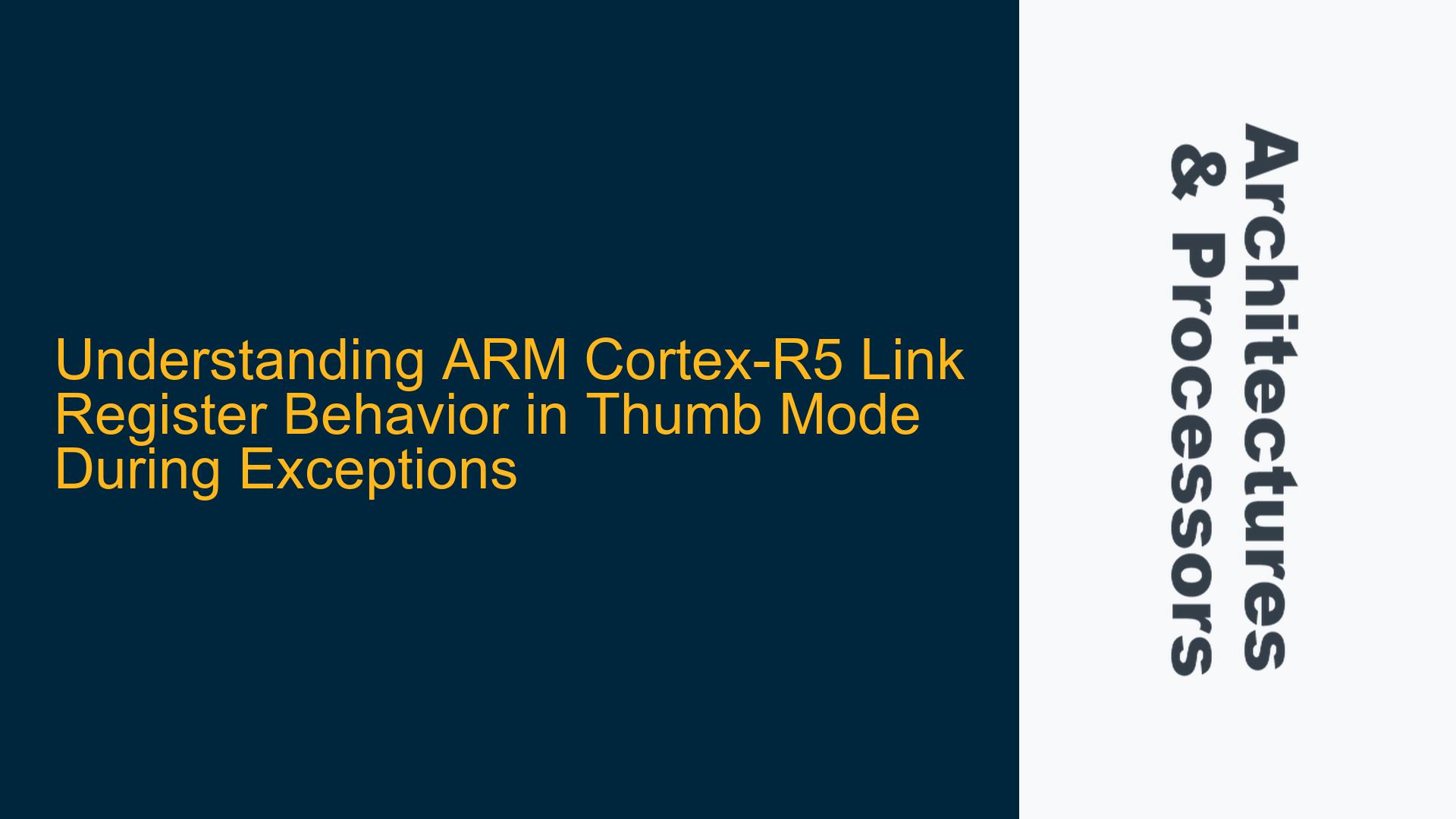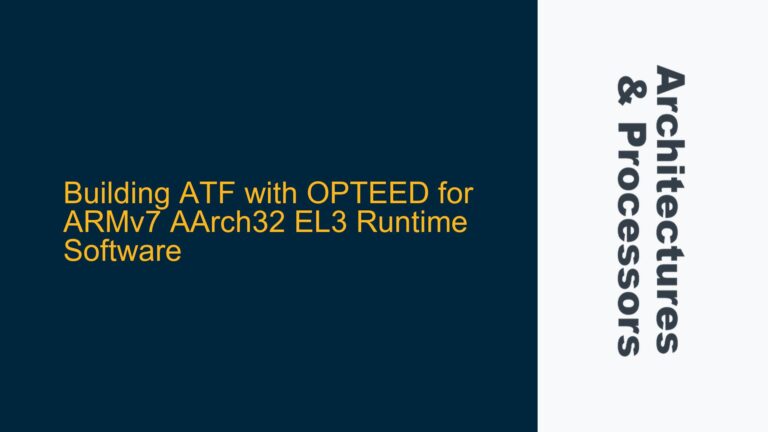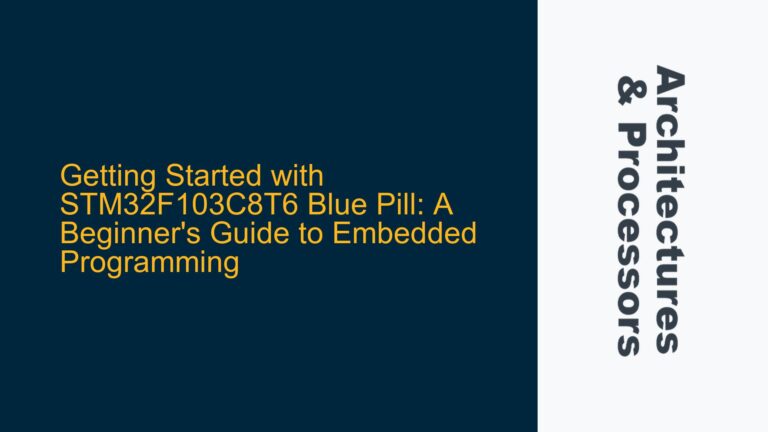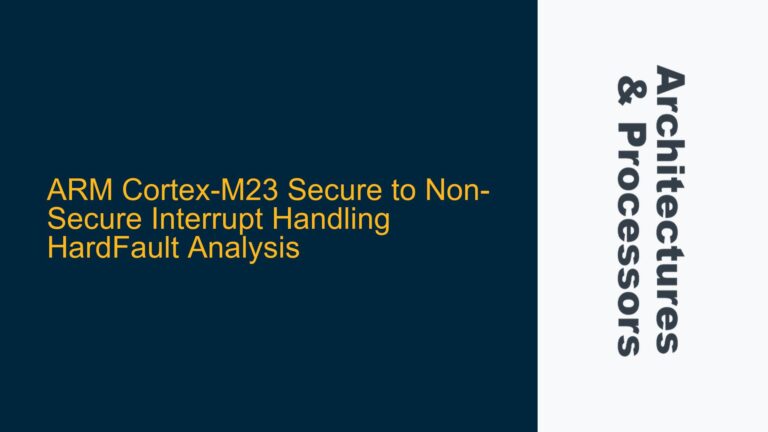ARM Cortex-R5 Link Register Offsets in Exception Modes
The ARM Cortex-R5 processor, like other ARM cores, handles exceptions by saving the return address in the Link Register (LR) of the respective exception mode. However, the value stored in the LR can vary depending on the processor mode (ARM or Thumb) and the type of exception. Specifically, the LR values for Fast Interrupt Request (FIQ), Interrupt Request (IRQ), and Data Abort (DABT) exceptions exhibit unique behaviors that are not immediately intuitive, especially in Thumb mode. This post delves into the architectural reasons behind these behaviors, focusing on why the LR in FIQ mode stores the instruction address plus 4 in Thumb mode instead of the expected plus 2, and why the LR in DABT mode stores the instruction address plus 8 in both ARM and Thumb modes.
ARM Cortex-R5 Exception Handling and Instruction Pipeline
To understand the behavior of the Link Register during exceptions, it is essential to first examine the ARM Cortex-R5’s exception handling mechanism and its instruction pipeline. The Cortex-R5 employs a dual-issue superscalar pipeline, which allows it to fetch, decode, and execute multiple instructions simultaneously. This pipeline architecture has implications for how the processor handles exceptions, particularly in terms of instruction prefetching and program counter (PC) calculation.
When an exception occurs, the processor must save the return address to the LR of the exception mode. The return address is typically the address of the instruction that was being executed when the exception was triggered. However, due to the pipeline’s nature, the PC value at the time of the exception may not correspond directly to the instruction that caused the exception. Instead, the PC may point to an instruction further along in the pipeline, depending on the stage at which the exception was detected.
In ARM mode, instructions are 4 bytes wide, and the PC typically points to the instruction being executed plus 8 (due to the pipeline’s prefetching behavior). In Thumb mode, instructions are 2 bytes wide, and the PC typically points to the instruction being executed plus 4. However, this behavior can vary depending on the exception type and the processor’s internal state.
Link Register Offsets in FIQ, IRQ, and DABT Modes
The ARM Cortex-R5 Technical Reference Manual specifies different LR offsets for different exception modes. These offsets are summarized in the following table:
| Exception Mode | ARM Mode Offset | Thumb Mode Offset |
|---|---|---|
| FIQ | IA + 4 | IA + 4 |
| IRQ | IA + 4 | IA + 4 |
| DABT | IA + 8 | IA + 8 |
FIQ Mode Link Register Offset
In FIQ mode, the LR stores the instruction address plus 4 in both ARM and Thumb modes. This behavior is consistent with the processor’s pipeline architecture. When an FIQ occurs, the processor saves the address of the next instruction to be executed, which is typically the current instruction address plus 4 in Thumb mode. This is because the FIQ is designed to be a fast interrupt, and the processor must ensure that the return address is correctly aligned to allow for rapid exception handling.
The reason for the plus 4 offset in Thumb mode, instead of the expected plus 2, lies in the way the Cortex-R5 handles instruction prefetching and pipeline staging. In Thumb mode, the processor prefetches two instructions at a time, resulting in a pipeline stage where the PC is incremented by 4 rather than 2. This prefetching behavior ensures that the processor can quickly resume execution after handling the FIQ, without needing to recalculate the instruction address.
IRQ Mode Link Register Offset
In IRQ mode, the LR also stores the instruction address plus 4 in both ARM and Thumb modes. This behavior is similar to that of FIQ mode, as both FIQ and IRQ are types of interrupts that require rapid handling. The plus 4 offset in Thumb mode is again a result of the processor’s prefetching mechanism, which ensures that the return address is correctly aligned for efficient exception handling.
The consistency between FIQ and IRQ modes in terms of LR offsets is intentional, as both modes are designed to handle interrupts with minimal latency. By using the same offset, the Cortex-R5 simplifies the exception handling process and ensures that the processor can quickly switch between different interrupt modes without needing to adjust the return address calculation.
DABT Mode Link Register Offset
In DABT mode, the LR stores the instruction address plus 8 in both ARM and Thumb modes. This behavior is different from that of FIQ and IRQ modes, and it reflects the unique nature of data aborts. A data abort occurs when the processor attempts to access memory that is either invalid or protected, and it typically involves a load or store instruction.
The plus 8 offset in DABT mode is a result of the processor’s pipeline architecture and the way it handles memory access instructions. In ARM mode, the PC typically points to the instruction being executed plus 8 due to the pipeline’s prefetching behavior. In Thumb mode, the same logic applies, but the offset is adjusted to account for the smaller instruction size. The plus 8 offset ensures that the processor can correctly identify the instruction that caused the data abort, even if the abort was triggered by a memory access that occurred several pipeline stages after the instruction was fetched.
Implementing Correct Exception Handling in ARM Cortex-R5
To ensure correct exception handling in the ARM Cortex-R5, developers must be aware of the LR offsets for different exception modes and understand how these offsets are influenced by the processor’s pipeline architecture. The following steps outline the key considerations for implementing exception handling in the Cortex-R5:
Understanding the Pipeline Architecture
Developers must first understand the Cortex-R5’s pipeline architecture, including its dual-issue superscalar design and instruction prefetching behavior. This understanding is crucial for correctly interpreting the LR offsets and ensuring that the processor can resume execution after handling an exception.
Configuring Exception Handlers
Exception handlers must be configured to account for the LR offsets in different exception modes. For example, when handling an FIQ or IRQ, the exception handler must adjust the return address stored in the LR to ensure that the processor resumes execution at the correct instruction. Similarly, when handling a DABT, the exception handler must account for the plus 8 offset to correctly identify the instruction that caused the abort.
Implementing Data Synchronization Barriers
In some cases, developers may need to implement data synchronization barriers (DSBs) to ensure that the processor’s pipeline is flushed before handling an exception. This is particularly important in scenarios where the exception handler needs to access memory that may have been modified by the instruction that caused the exception. By implementing DSBs, developers can ensure that the processor’s pipeline is in a consistent state before proceeding with exception handling.
Testing and Validation
Finally, developers must thoroughly test and validate their exception handling code to ensure that it behaves correctly under all possible scenarios. This includes testing the code with different types of exceptions, in both ARM and Thumb modes, and verifying that the processor resumes execution at the correct instruction after handling each exception.
Conclusion
The behavior of the Link Register in the ARM Cortex-R5 during exceptions is influenced by the processor’s pipeline architecture and the specific requirements of each exception mode. By understanding the reasons behind the LR offsets in FIQ, IRQ, and DABT modes, developers can implement correct and efficient exception handling in their embedded systems. This involves a deep understanding of the Cortex-R5’s pipeline architecture, careful configuration of exception handlers, and thorough testing and validation to ensure that the system behaves as expected under all conditions.






